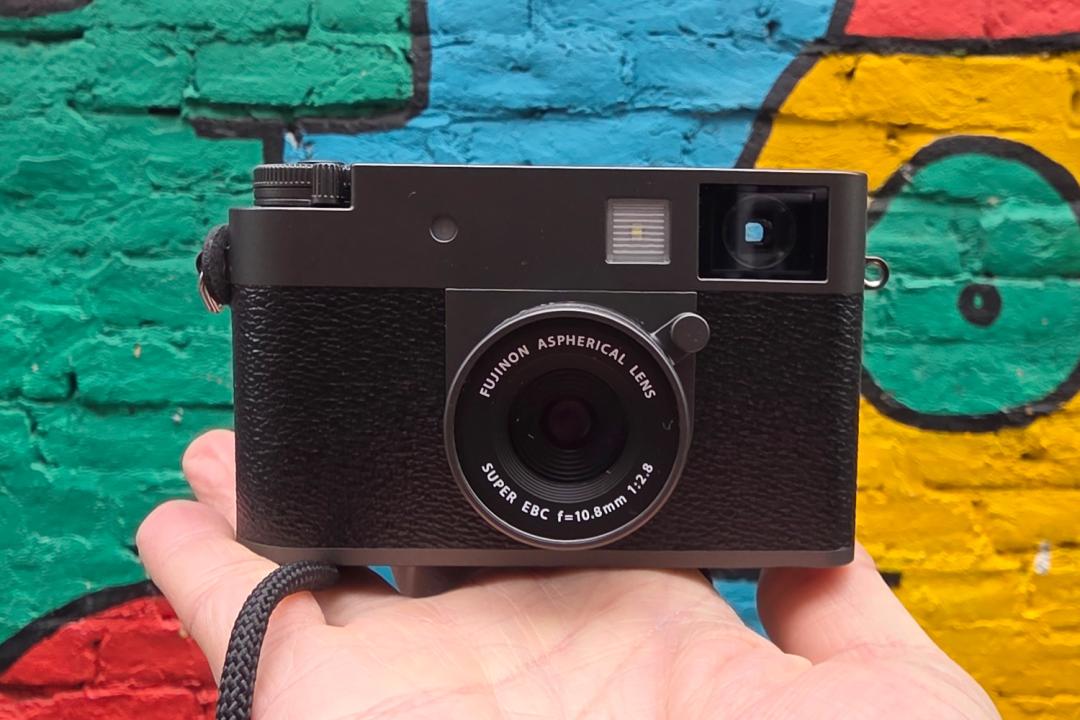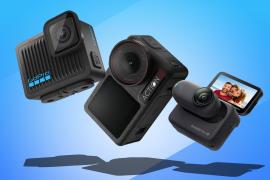An hour with the Fujifilm X-Half left me nostalgic for analogue film
Eccentric snapper puts the fun back into photography

Fujifilm has done more to make compact cameras cool that just about any other camera brand, but the new X-Half might just make them sub-zero. Sitting somewhere between modern mirrorless camera and retro toy, it’s is a true love letter to a niche form of analogue film – just one that was written in the digital age. The underlying hardware might not be much to shout about, but for sheer fun factor it’s going to take some real beating.
No prizes for guessing which camera Fuji took design inspiration from; the X-Half looks just like an X100VI that shrunk in the wash. You can get one in the same Silver or Black colours, as well as a new Charcoal option. It’s about as big as a disposable film camera (if you’re old enough to remember one of those) and almost as light. Chalk some of that up to the polycarbonate construction, which avoids feeling cheap. That’s appreciated, as this isn’t a pocket change camera. It’ll set you back $850/£699, or only a little less than the interchangeable lens X-M5.
It’s not like you’re getting high-end hardware for your cash, either. There’s a 1in sensor at the X-Half’s heart, which is half the size of Fuji’s APS-C norm. Pixel count maxes out at 18MP, and it’s paired to a 10.8mm, f/2.8 fixed focal length lens with no image stabilisation or even a filter thread.
The rest of the camera is pretty basic, with just an exposure compensation dial on the top plate. Aperture and manual focus controls are built into the fixed lens. There’s a cold shoe for accessories (though I’m not sure which ones would actually prove useful) and an LED flash. A single SD card slot handles storage. Fuji says the battery is good for up to 880 shots, and charges over USB-C.



The focus is very much on the shooting experience here. You can only take JPEGs (no RAWs), so the firm’s trademark film simulations are baked in once you press the shutter button. There’s a second screen on the back of the camera dedicated to showing which simulation is active; it looks like a window highlighting an analogue film canister inside the camera. There’s an optical viewfinder for composition, but it doesn’t have the fancy hybrid gubbins as seen on the X100 VI; just a green LED to indicate when the single-zone autofocus has locked onto a subject.
With the sensor oriented for 3:4 vertical shooting, the X-Half fully embraces the niche half-frame format – named because each shot is half the width of an image shot on 35mm film – for the social sharing era. The rear touchscreen is even styled to match, with a refreshing lack of buttons next to it. Everything is controlled with swipes and taps. The UI has been simplified greatly, too, so there aren’t hundreds of menus to sift through – just the essentials.
A film winder next to the shutter button is the icing on the cake. Pulling it takes a 2-in-1 diptych, or side-by-side shot, while pushing it in previews the last shot. You can mix and match stills with video in a single diptych, too. I wish the winder had a ratcheting feel, but the way it springs back after every pull is very satisfying. The shutter has the soft click of a film camera, rather than the heavy thunk of a mirrorless digital one.
Even more fun is the Film Camera mode, which lets you take 36, 54 or 72 shots before ‘developing’ them – along with a contact sheet – via the X-Half smartphone companion app. Image previews are disabled until you complete the ‘roll’, and you can also apply a handful of analogue effects like light leak and expired film. You’ve got to remember that the optical viewfinder is offset from the lens, though; the few shots I framed precisely didn’t line up after developing.
Whichever mode you’re in, the shots the X-Half takes are full of Fuji’s signature colour science. There’s real warmth and contrast on display, and I was pleasantly surprised at how crisp some of my test shots came out; the lens may be more ‘characterful’ than Fuji’s usual optics, but that doesn’t mean it’s bad. There may be fewer film simulations here than you’ll get on the firm’s regular X-series cameras, but the big hitters are all present and correct, including two of my favourites, Classic Chrome and Reala Ace. Each gives your shots a distinctive feel, and I liked being locked into one for an entire ‘roll’ at a time.



I don’t shoot in portrait very often, so being forced into it here meant not relying on my usual compositions, and thinking more about framing each shot. It’s a world away from today’s multi-talented mirrorless cameras, which can tackle pretty much any conditions. Walking around East London with the camera gripped between thumb and forefinger felt freeing, too; I wasn’t constantly reviewing each shot, but looking for my next subject or location.
I’ll have to withhold judgment on how well the 1in sensor holds up in low light, although outright image quality isn’t the ultimate goal here; like an analogue film camera, a lot of the appeal is how imperfect images still convey the mood and intention of the photographer.











Having spent an hour with the X-Half, I’m convinced its limitations are part of the charm. This is a fun camera that makes you think about composition rather than the minutiae of ISO values and the like; and with no option for RAW editing later, what you shoot is what you get. That will surely make it a hit with social media sharers who want to get their pics live ASAP.
At $850/£699 it’s hardly an impulse purchase – but if you’re willing to pay for retro charm, this camera has plenty of it.
The Fujifilm X-Half is up for pre-order now. Cameras start shipping from June 12.


